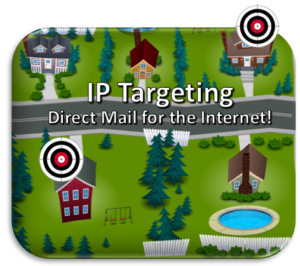 Household IP targeting is the perfect product to use when you need to target one-on-one to specific households and reach a very niche audience. This product works through a patented technology of matching IP addresses to a database of names and physical street addresses and displaying your display or video ads only to those households (or businesses). It works without cookies and cannot be deleted or blocked. We are able to stay connected to every household, every time they go online with extraordinarily relevant online ads.
Household IP targeting is the perfect product to use when you need to target one-on-one to specific households and reach a very niche audience. This product works through a patented technology of matching IP addresses to a database of names and physical street addresses and displaying your display or video ads only to those households (or businesses). It works without cookies and cannot be deleted or blocked. We are able to stay connected to every household, every time they go online with extraordinarily relevant online ads.
One of the more common questions we get about Household IP targeting is “How often do IP addresses change?”
Research has found that many households that have dynamic IP addresses (meaning the IP address is randomly assigned and can change) actually have held the same IP address for multiple years. We have found that the average household targeted by one of our IP Targeting campaigns has had the same IP address for nine months.
Even though an IP address is “dynamic” misinformed folks tend to take that as meaning your Internet Service Provider (ISP) is constantly issuing a new IP address to your house every time you go on line. This was the case when we were on dial up systems in the mid 90s that required a unique connection between the ISP and modem, and where an IP address from their available pool was provisioned as needed then removed upon disconnecting from the internet.
Today we have more constant connectivity to the internet. Most users do not disconnect their modems when not home or not in use. This change in use over the years has led to ISPs needing to keep a more consistent and live connection with a household modem.
Every 14 days there is a DHCP lease renewal that takes place that acts kind of like a handshake between the ISP and a household modem. If the connection is still valid the ISP will move on and not disrupt service via provisioning a new IP address. There are multiple reasons they do not issue a new IP every time this lease renewal takes place:
- The removal and re-provisioning of an IP disrupts service to the household.
- There are hardware and bandwidth costs to execute these processes. Then there are support costs to deal with the lapses in service when this takes place.
The beauty of our Household IP targeting system is that it adapts to the changing IP landscape via the ingestion of first party data (it ingests over 1 million first party records a second). When we have enough evidence indicating an IP address does in fact represent a household address we can move that pairing into our confidence interval that is at least 95% accurate. When an IP to a household changes, we have records indicating this to be the case, we then remove the pairing from our confidence interval until we have enough instances indicating this new IP represents the household.
Another often asked question is “Why can’t we match every household on a list to an IP address?”
Most common reasons include:
- Some people don’t have in-home internet.
- Some houses don’t have enough traffic for us to be able to get good data.
- Some people’s IP addresses have recently changed and we don’t have enough data on the new IP yet.
If you have any questions about Household IP Targeting, let us know!
